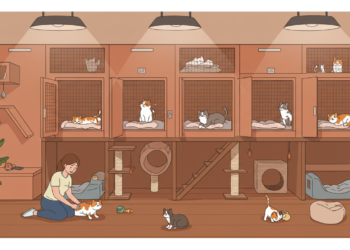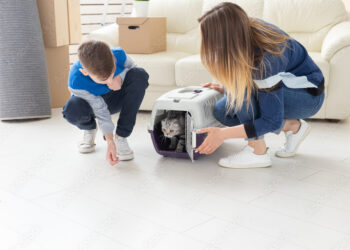Just as humans can get cystitis, so can cats. There are several possible reasons for this. It is important to signal this to the cat in good time, in the vast majority of cases something can be done about it. How do you identify a bladder infection in a cat and how should the cat be treated to get rid of the bladder infection?
Cystitis, what is it and what are the causes?
A bladder infection is an inflamed inside of the bladder wall. There are several causes for this, one of which is a bacterial infection. Certainly in humans, this is usually the main cause. In the case of cats, and especially the younger cat, this is the cause in lesser cases.
A more common cause is FIC, feline idiopathic cystitis. One of the main causes of this is stress in the cat. The cat is an insider*, so you don’t always notice it quickly enough if the cat is under persistent stress.
Reading suggestions; 200+ Unique Female Cat Names for Your Cute Companion
Think of changing environments, taking over stress from the owner, etc. FIC can also have an abnormal mucus layer in the bladder as a basis or overstimulation of the bladder.
* A cat as an inner fat actually means that you will not see/notice much about the cat if it is bothered by something. The cat does not really express itself, not in behavior, not in making sounds, not asking for extra attention, etc.
Furthermore, drinking very little, causing the cat to get more concentrated urine, can be a cause. The same applies to overweight and little exercise, which can also play a role in the development of cystitis.
The number of cats with a local tumor that causes cystitis is minimal.
Finally, bladder stones can also cause cystitis. Bladder stones can lead to complete constipation, even more so in the male (smaller urethra) than the female. The vet must act quickly. Cats that have had bladder stones are usually on special food for life.
Unfortunately, there are also cases of cystitis where the ultimate cause cannot be traced.
know your cat
It is important in several ways that you know your cat. Not infrequently you only notice in the cat that it is suffering from something if you observe the animal more closely. This inner greaser is a master at masking what bothers them.
Symptoms
However, you can recognize a cat with a bladder infection by a number of things, namely:
- Difficult or painful urination, they then meow plaintively and urinate in very small amounts.
- If the cat urinates outside the litter box more often.
- If there is blood in the urine.
- Straining when urinating while hardly anything comes out.
- If they brush extra at the vagina or penis.
- If the urine has a strongly off-label odor.

How do you solve a bladder infection?
If you think your cat has cystitis, collect some urine. In this way, the vet can quickly find out whether it is indeed a bladder infection. By the way, the vet can usually also find out with an ultrasound whether the cat has a bladder infection.
Reading suggestions; Dog Health Issues: Anemia
Treatment at the vet
Once the cat has a bladder infection, it is important to treat the inflammation primarily. In most cases, this means: administering painkillers with an anti-inflammatory agent (by the vet). If the infection is bacterial, an antibiotic is a remedy.
In both cases, it is advisable to give bladder relaxants. This is important because in many cases the bladder wall is irritated, which can lead to the urge to push. In order to calm the bladder, more actions will have to be taken simultaneously.
What can you do as an owner?
Depending on the cause, you as the owner can also take action. For example, if the cat is too fat, it is important that it lose weight. In this case, you have to look closely at the food and how the cat can obtain it.
There are various tools for this so that the cat has to make more effort to get to the kibble. You can also think of certain toys to get and keep the cat moving.
If stress is the cause, you can also take action yourself.
For example, there are various products on the market that make the cat calmer. These agents are also sometimes used when a new cat arrives (which can also cause stress). Not every remedy is equally effective for every cat.
It is therefore advisable to try out what has the most effect. Make sure the cat also has enough places to retreat. Making real ‘contact’ with your cat and, for example, playing with the cat, can also reduce stress.
If your cats are real indoor cats, then it is good to think about creating an outdoor space. A small run of fencing your garden or balcony in such a way that the cat cannot run off is recommended.
How to prevent bladder infections (in the future)?
No one can give you complete certainty that your cat will not get a bladder infection, but there is some preventive things you can take to prevent (again) bladder infection. You can think of:
- Always offer fresh water and preferably running water. For example, water bowls with fountains.
- Make sure the cat always has a clean litter box and preferably two litter boxes. If you have more cats, add one litter box.
- Distribute several litter boxes throughout the house.
- Prevent your cat from becoming overweight.
- Make sure the cat has at least one place of its own where it can really retreat.
An owner with a lot of stress can unconsciously and unintentionally transfer this to the cat. Don’t rely on what you see, the cat won’t show it right away.
If there is a lot of stress in the house that cannot be removed in the foreseeable future, it can be good for the cat to use anti-stress products preventively. If desired, coordinate this with the vet.
Finally
Cystitis seems harmless, but if you do not act or do not act adequately, it can indeed have far-reaching consequences for the cat. However, if you get it right with your vet, most cats will recover just fine. Sometimes in combination with a modified diet.










